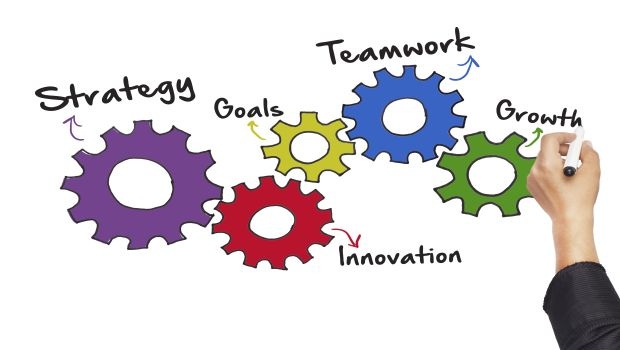The health and nutrition industry can enrich its relationship with consumers by engaging stakeholders, including employees, in corporate strategy.

At first glance, corporate vision statements don’t sound like a sexy topic. That could be because the mere mention of strategic planning brings visuals of long board meetings, endless staff data and analysis directives, and multiple volumes of plans gathering dust on senior management shelves.
According to a Jim Clayton, founder of Clayton Homes, strategic planning is boiled down to five stages of process:
1. Clarify the vision
2. Gather and analyze information
3. Formulate a strategy
4. Implement the strategy
5. Evaluate and control
This list was the top hit on a Google search, which is a bit surprising given Google’s vision is “to provide access to the world's information in one click” with a mission “to organize the world's information and make it universally accessible and useful.” Imagine the KPIs (key performance indicators) required!
And yet, when it works, it really works. What’s the secret sauce that makes this process work for Google’s bottom line? Consumer demand, of course. Employee satisfaction derived from rich benefits and flexibility is also key. That said, according to Payscale, 73 percent of Google employees find their jobs to be meaningful. Perhaps our age-tested model for strategic planning and its reliance on a top-down approach, with metrics that fail to consider the issues motivating employees or the consumers we serve, is rate-limited.
The dietary supplement industry is steeped in a rich culture rooted in the power of nature and a body’s innate ability to heal. Decades of industry leaders have articulated a promise to provide products and ingredients to support that culture. Yet, current times challenge its identity. Terms such as transparency, traceability, quality improvement, sustainability and supply chain management are discussed. Issues of quality and trust pervade conversation with consumers. All this discord drives opportunity for industry to be better, share more and get clear in its intentions. A brand articulating what motivates it is more important than ever. Implementation of that mission and vision can no longer be a paper exercise.
How can a company be in a partnership with all its stakeholders to benefit corporate objectives and effectively use corporate resources?
It should start by adjusting internal conversations and actions to reflect and embed the company’s legacy and mission throughout the company’s processes. The board must be aligned, and employees fully engaged. Does the company have the board composition and commitment required to address each component of the mission and vision? Has it evaluated the process for integration of the goals the board established and the impact upon each business unit by engaging the employees? Does it enlist feedback on the strategic direction and the impending measures it will require prior to implementation? Is the purpose ingrained in the fabric of each day? Does it know if employees are also customers? Everything from the charitable activities to health care benefits and the contents of vending machines stands as an opportunity to exemplify the company’s motives. Increasingly, employees want and need to be inspired by their company’s actions. Routinely, they seek meaning in the work they do to support the company.
Here are some key thoughts for revisiting the strategic plan:
· Transparency and traceability are no longer optional, and they must be visible to all. This is not just an intellectual exercise across marketing, sales, product development and manufacturing. This is a cultural process that acknowledges the skills of the team in the efforts to assimilate and ground the commitment to offering quality goods.
· Companies should address consumers and engage its workforce. The mission and vision can’t be achieved without the power of those that consume the products, regardless of whether the company is a raw ingredient supplier, contract manufacturer or distributor. Investments in research, education, project development and advocacy rely on that awareness being baked into the equation. In fact, a company committed to its journey and vision takes on the role of advocate for the consumer, the public at large and the world. Marshaling these resources is about how a company commits to expenditures and the people it leads. The reward comes in the form of innovation, a workforce driven to succeed, loyal customers, and lasting impact on health of people and planet. Being a force for good requires taking a big-picture view of the impact on generations to come.
· Companies should be great joiners. Companies need to make the most out of valuable dollars by partnering with trade associations when it makes sense. There is strength in numbers and weakness in going it alone. It is essential to understand the benefits of the association’s mission and membership in relation to the brand. Is the association’s work based in a value system that reflects the company? Does the company have expectations of membership that can’t be met? The guidepost is to make choices that serve the company’s consumers.
We’ve watched what happened in the consumer packaged goods (CPG) industry when companies like Campbell’s Soup took on consumer demand as a mantle. They left the Grocery Manufacturers Association (GMA) and almost brought the 110-year-old organization to its knees, diminishing the impact of a US$760 billion industry. The industry can collectively take a page from that manual and enrich its relationship with consumers by engaging stakeholders, including employees, in corporate strategy.
Karen Howard is CEO and executive director of the Organic & Natural Health Association. She has spent more than 30 years working with Congress, state legislatures and health care organizations to develop innovative health care policy and programs. Howard has held a variety of executive positions, and has policy expertise in integrative medicine, managed care, health care technology and mental health. She previously served as president of the National Animal Supplement Council (NASC). Howard also served as executive director for the American Association of Naturopathic Physicians (AANP) and the Association of Accredited Naturopathic Medical Schools.
Business ROI at SupplySide West
Learn more about crafting a and engaging the workforce in a corporate vision statement during the “Boosting Your ROI: Secrets to Business Success” on Thursday, Nov. 8 at SupplySide West in Las Vegas.
About the Author(s)
You May Also Like






.png?width=800&auto=webp&quality=80&disable=upscale)